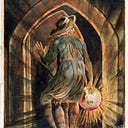“What is now proved was once only imagined.”- William Blake
In a study, related to widespread neural networks Dartmouth researchers defined what they call “the brain’s ‘mental workspace” . The Dartmouth team’s findings, titled “Network structure and dynamics of the mental workspace,” appeared the week of Sept.16 issue of the Proceedings of the National Academy of Sciences. Their work may help us understand how great artists and creators like Leoarndo da Vinci could create masterpieces like the Mona Lisa and the Last Supper.
Leonardo was a true genius who graced us with his presence from April, 1452 to May 2, 1519. He is among the most influential artists in history, having left a significant legacy not only in the realm of art but in science as well, each discipline informing his mastery of the other.
Da Vinci lived in a golden age of creativity among contemporaries like Raphael (1483–1520) and Michaelangelo, ( 1475–1564 ) and contributed his unique genius to virtually everything he touched but his approach to his work teaches us all to persist and persevere. Leonardo didn’t start by painting the Mona Lisa. Recent academic work suggests that it would not have been started before 1513 only six years before Leonardo’s death. Almost all of da Vinci’s work is about iteration and developing improved iterations for each of his works.
“Landscape with Waterfall” is one of the oldest known surviving artworks by Leonardo Forensic analysis of “landscape with waterfall” revealed that it was created in two successive phases, suggesting that it’s not the depiction of a real landscape, but rather a result of da Vinci’s geological research over the years.
With the Last Supper there are numerous sketches, like the following Leonardo drew long before he put paint to canvas.
Last Supper Progression
The Isleworth Mona Lisa, on the left below, is an oil-on-canvas painting of the same subject as Leonardo da Vinci’s Mona Lisa, on the right. In 2015 and 2016, peer-reviewed academic publications concerning it confirmed its attribution to Leonardo da Vinci.
Mona Lisa Progression
In 1913 English connoisseur Hugh Blaker spotted and acquired the painting which had been hanging for over a century in a manor house in Somerset, having been bought in Italy as an original Leonardo. In a monograph published shortly thereafter, Blake’s stepfather, John R Eyre, proposed that two versions of the Mona Lisa had been worked on by Leonardo; the “Isleworth” picture (named after the location of Blaker’s studio in Isleworth, west London) being the first.
The Mona Lisa is thought to be a portrait of Lisa Gherardini, the wife of Francesco del Giocondo even though Leonardo still visually interpreted what and how he saw his model. It’s believed Loenardo was the first to recognize the special optical qualities of the eye. He wrote “The function of the human eye … was described by a large number of authors in a certain way. But I found it to be completely different.” His main experimental finding was that there is only a distinct and clear vision at the line of sight — the optical line that ends at the fovea. Although he did not use those words literally he actually is the father of the modern distinction between foveal and peripheral vision.
According to Leonardo the eye has a central line and everything that reaches the eye through this central line can be seen distinctly. So it is for each artist to apply his central line to interpret his particular subject matter.
Physicist and poet, Jacob Bronowski, has written extensively how the source of all human creativity both in science and art emerges from human imagination. According to Dr. Bronowski “the most interesting thing about man is that he is an animal who practices art and science and, in every known society, practices both together.”
In his essay “The Reach of Imagination” Dr. Bronowski, describes how “To imagine is the characteristic act, not of the poet’s mind, or the painter’s mind, or the scientist’s, but of the mind of man.”
Dr. Bronowski ,who was a William Blake scholar, loved to quote Blake, and would frequently remind his readers “What is now proved was once only imagined.” allowing us to understand how critical human imagination is to all that we know. He once wrote; “The power that man has over nature and himself, and that a dog lacks, lies in his command of imaginary experience. The symbol is the tool which gives man his power, and it is the same tool whether the symbols are images of words, mathematical signs or mesons.”
Before Leonardo could paint either his Last Supper or Mona Lisa each appeared as symbols in his mind. “The symbol is the tool which gives man his power, and it is the same tool whether the symbols are images of words, mathematical signs or mesons.” — J. Bronowski, The Reach of Imagination
